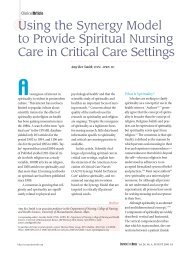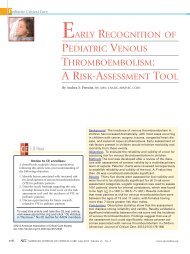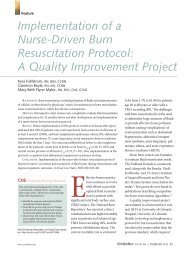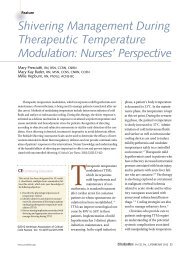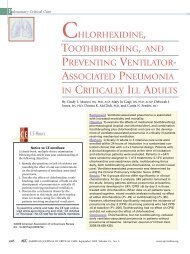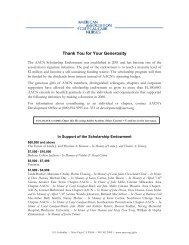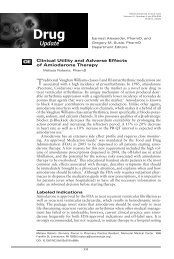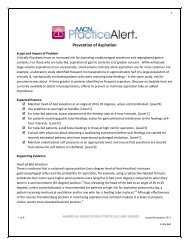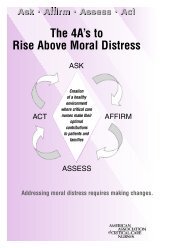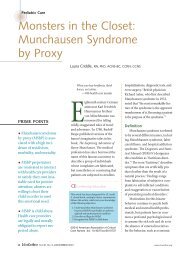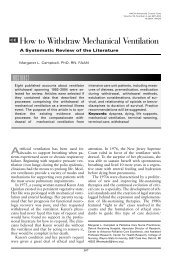CCRN/PCCN Exam Handbook - American Association of Critical ...
CCRN/PCCN Exam Handbook - American Association of Critical ...
CCRN/PCCN Exam Handbook - American Association of Critical ...
You also want an ePaper? Increase the reach of your titles
YUMPU automatically turns print PDFs into web optimized ePapers that Google loves.
Nurse Characteristics<br />
Nursing care reflects an integration <strong>of</strong> knowledge, skills,<br />
abilities and experience necessary to meet the needs <strong>of</strong><br />
patients and families. Thus, nurse characteristics are<br />
derived from patient needs and include:<br />
Clinical<br />
Judgment<br />
Advocacy/<br />
Moral<br />
Agency<br />
Caring<br />
Practices<br />
Collaboration<br />
Systems<br />
Thinking<br />
Response to<br />
Diversity<br />
Facilitation<br />
<strong>of</strong> Learning<br />
Clinical<br />
Inquiry<br />
AACn syneRgy ModeL foR PAtIent CARe (CONTINueD)<br />
Clinical reasoning, which includes clinical<br />
decision making, critical thinking and a global<br />
grasp <strong>of</strong> the situation, coupled with nursing skills<br />
acquired through a process <strong>of</strong> integrating<br />
education, experiential knowledge and evidencebased<br />
guidelines.<br />
Working on another's behalf and representing the<br />
concerns <strong>of</strong> the patient/family and nursing staff;<br />
serving as a moral agent in identifying and<br />
helping to resolve ethical and clinical concerns<br />
within and outside the clinical setting.<br />
Nursing activities that create a compassionate,<br />
supportive and therapeutic environment for<br />
patients and staff, with the aim <strong>of</strong> promoting<br />
comfort and healing and preventing unnecessary<br />
suffering. These caring behaviors include but are<br />
not limited to vigilance, engagement and<br />
responsiveness <strong>of</strong> caregivers. Caregivers include<br />
family and healthcare personnel.<br />
Working with others (e.g., patients, families,<br />
healthcare providers) in a way that<br />
promotes/encourages each person's contributions<br />
toward achieving optimal/realistic patient/family<br />
goals. Collaboration involves intra- and interdisciplinary<br />
work with colleagues and community.<br />
body <strong>of</strong> knowledge and tools that allow the nurse to<br />
manage whatever environmental and system<br />
resources that exist for the patient/family and staff,<br />
within or across healthcare systems and nonhealthcare<br />
systems.<br />
The sensitivity to recognize, appreciate and<br />
incorporate differences into the provision <strong>of</strong> care.<br />
Differences may include, but are not limited to,<br />
individuality, cultural, spiritual, gender, race,<br />
ethnicity, lifestyle, socioeconomic, age and<br />
values.<br />
The ability to facilitate learning for<br />
patients/families, nursing staff, other members <strong>of</strong><br />
the healthcare team and community. Includes<br />
both formal and informal facilitation <strong>of</strong> learning.<br />
The ongoing process <strong>of</strong> questioning and evaluating<br />
practice and providing informed practice. Creating<br />
changes through evidence-based practice,<br />
research utilization and experiential knowledge.<br />
Nurses become competent within each continuum at<br />
a level that best meets the fluctuating needs <strong>of</strong> their<br />
population <strong>of</strong> patients. More compromised patients have<br />
more severe or complex needs, requiring nurses to have<br />
advanced knowledge and skills in an associated<br />
continuum.<br />
FOR ExAMPLE:<br />
If the gestalt <strong>of</strong> a patient were stable but unpredictable,<br />
minimally resilient and vulnerable, primary competencies <strong>of</strong><br />
the nurse would be centered on clinical judgment and caring<br />
practices (which includes vigilance). If the gestalt <strong>of</strong> a patient<br />
were vulnerable, unable to participate in decision making and<br />
care, and inadequate resource availability, the primary<br />
competencies <strong>of</strong> the nurse would focus on advocacy and<br />
moral agency, collaboration and systems thinking.<br />
although all eight competencies are essential for<br />
contemporary nursing practice, each assumes more<br />
or less importance depending on a patient’s characteristics.<br />
Synergy results when a patient’s needs and<br />
characteristics are matched with the nurse’s<br />
competencies.<br />
results <strong>of</strong> a 1997 large-scale survey <strong>of</strong> subacute, acute<br />
and critical care nurses across the united States<br />
supported the applicability <strong>of</strong> the Synergy Model to<br />
nursing practice (Greenberg, Muenzen & Smith, 1998).<br />
a second study, including adult, pediatric and neonatal<br />
CCrNs, identified the overall contribution <strong>of</strong> each <strong>of</strong> the<br />
eight nurse characteristics to optimal patient outcomes.<br />
based on these studies, as well as the 2008 job analysis<br />
completed by aaCN Certification Corporation, the Test<br />
Plans for aaCN certification exams have been created to<br />
reflect the Synergy Model, as well as current acute and<br />
critical care nursing practice.<br />
For more information about the aaCN Synergy Model for<br />
Patient Care visit www.certcorp.org.<br />
7



